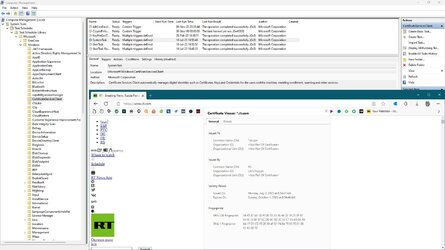Exactly this,
Any servers based in the US, Germany, Canada and I'm sure even other states influenced by the US cannot be trusted.
This isn't only about DNS but also any kind of server which users frequently use such as email providers are also affected,
According to this site Privacy-Conscious Email Services
And according to this site: PRISM Break
But this is perhaps nothing new except when we face it on our own skin as it is the case now proving that Edward Snowden was correct about all that he said and is still saying.
If a government can tell cloudflare to hijack DNS then they can also tell Microsoft or any other firm or entity what to do if they want.
Both scenarios present differing levels of complexity, practicality, and potential repercussions.
It's conceivable that DNS servers, particularly those operated by Western entities, are receiving systematic orders to interfere with the security certificates of rt.com, and potentially other news websites, whose narratives are seen as discordant.
1. Compelling a DNS server to tamper with DNS queries:
From a technical perspective, this is less complex than compromising an operating system like Windows. A DNS server could, for example, be compelled to redirect traffic from one domain to another or return inaccurate IP addresses. This would be considered a form of DNS spoofing or poisoning.
From a practicality standpoint, this might be easier to achieve on a small scale, but managing this on a larger scale could be challenging due to the distributed nature of DNS, the number of DNS servers globally, and the fact that users can easily change their DNS servers.
In terms of repercussions, this could lead to significant breaches of trust and potential legal issues, especially if the DNS servers are run by reputable companies. It might also encourage more users to use encrypted DNS or DNS over HTTPS (DoH), making it harder for such tampering to occur in the future.
2. Compelling Microsoft to compromise its software:
Technically, this is more complex. Compromising an operating system without it being detected by security researchers would require sophisticated techniques. Moreover, any updates issued by Microsoft would need to maintain this compromise, adding another layer of complexity.
Practically, if a government could compel Microsoft to introduce a backdoor or similar compromise into Windows, it would potentially give them access to a large number of devices globally. However, the logistics and legality of compelling such action on a major corporation would be significantly challenging.
Repercussions would be severe. If discovered, the damage to Microsoft's reputation would be substantial, and the legal implications could be enormous. It would also likely lead to a significant shift in the tech industry, with users and companies looking for more secure alternatives.
In both cases, the feasibility would depend heavily on jurisdiction and the legal frameworks in place to protect companies and individuals from such government demands.
My Computer
System One
-
- OS
- Windows 11 Pro





















